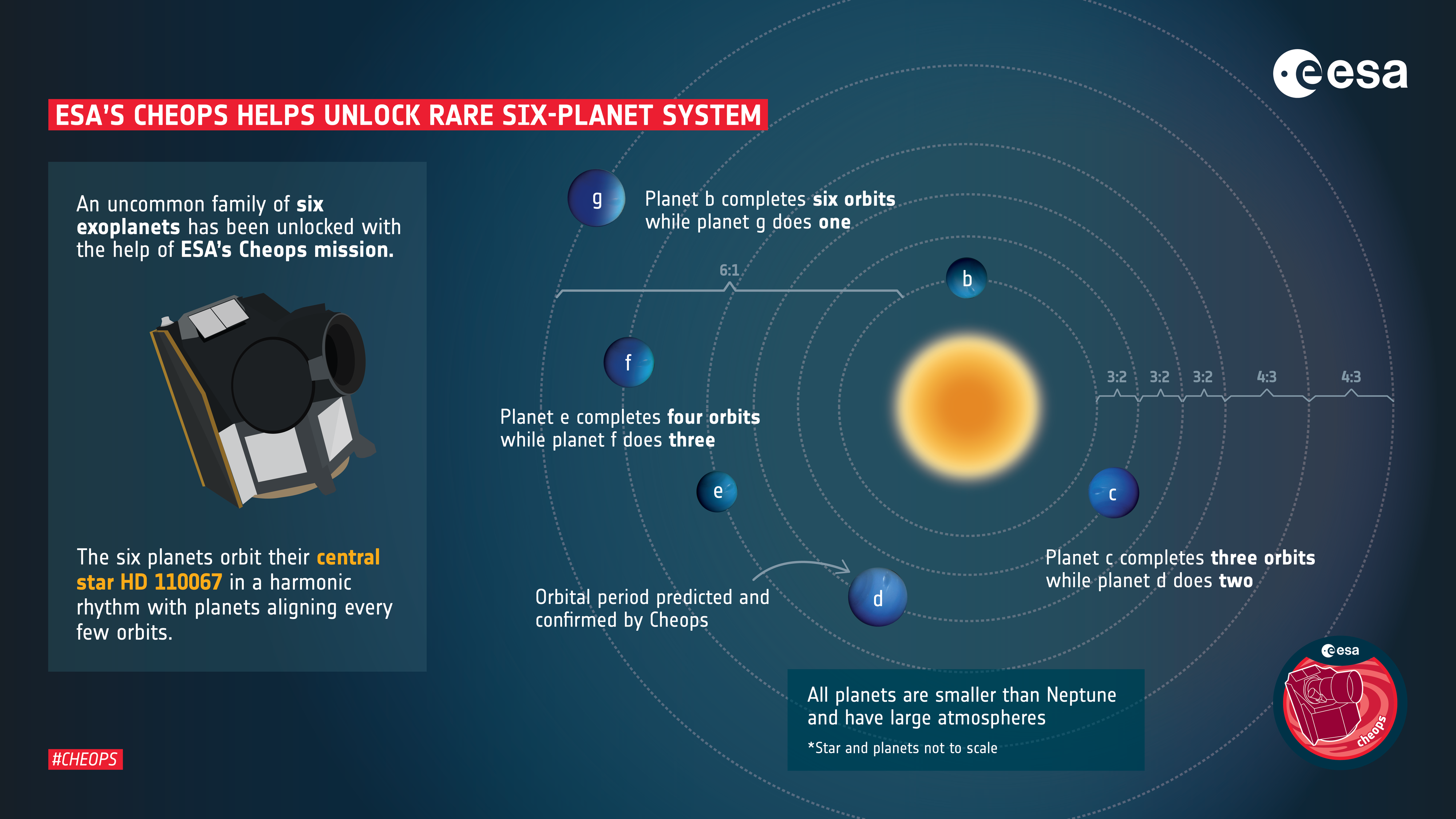An international team of astronomers was able to solve the peculiar observations of possible planets around star HD 110067. Original observations from NASA’s Transiting Exoplanet Survey Satellite (TESS) suggested the presence of two planets, and follow-up observations did not find the original but two different planets still. It took more detailed observations with another telescope to reveal the truth: a truly unique system of six planets.
The latest observations were conducted with the European Space Agency’s Cheops (CHaracterising ExOPlanet Satellite). HD 110067 hosts six planets, a fact that is already impressive in itself. But what makes it even more special is that the orbits of these planets are in resonance. For example, the closest planet to the star does three orbits for every two orbits of the second closest, and the second closest does three orbits for every two of the third one.
Resonance is believed to occur at the beginning of every planetary system but it is easily disturbed. A passing star, a collision, or a giant planet, might easily mess up the configuration. But in this system, resonance has kept going unchanged since its birth, over 4 billion years ago.

An infographic showing the resonance between the different planets in the system.
Image Credit: ESA
“We think only about one percent of all systems stay in resonance,” corresponding author Rafael Luque, from the University of Chicago, said in a statement seen by IFLScience. “It shows us the pristine configuration of a planetary system that has survived untouched.”
But it is not just about studying the system as a whole. It’s also about the individual planets. The six worlds are subneptunes, with a radius between 1.94 times to 2.85 times that of Earth. The team was able to infer the presence of thick atmospheres. They orbit the star in between nine and 54 days, making this a super compact system. Cheops has previously found a five-planet system in resonance.
Similar compact systems are known, such as TRAPPIST-1, which is 40 light-years from us. HD 110067 is 20 percent dimmer than our Sun but when the comparative size and distances are taken into account, it ends up being 10,000 times brighter in visible light than TRAPPIST-1. And that’s despite being 100 light-years away. This is the brightest known star to have more than four planets.
“The amount of light we receive from that star is larger than what we receive from other stars with many planets,” Professor Enric Palle, from the Instituto de Astrofisica de Canarias, said during a press conference.
The combination of star brightness and extended atmospheres makes this system a perfect one to study the composition of subneptunes’ atmosphere, and how different these planets may be from one another. We do not have these kinds of planets in our Solar System but they are very common in the universe.
“These transiting systems are worth their weight in gold. Because they pass in front of the stars you get all this extra information such as a very precise radius and you can get starlight filtering through the atmosphere, which enables you to measure the atmospheric constituents – molecules in the atmosphere. You can’t do any of that for the planets that don’t transit,” Dr Hugh Osborn, from the University of Bern, said during the press conference.
Future work will see the team refine the masses of the planets, which will provide even more insights into the nature of subneptunes. And they hope that the atmospheres will be studied as well. This is a perfect system for JWST to study. The team stated that the space telescope is currently the only one that could characterize the atmosphere for all six planets.
A paper describing these findings is published in the journal Nature.
Source Link: 6-Planet Harmony Solves Mystery Of Peculiar Star System